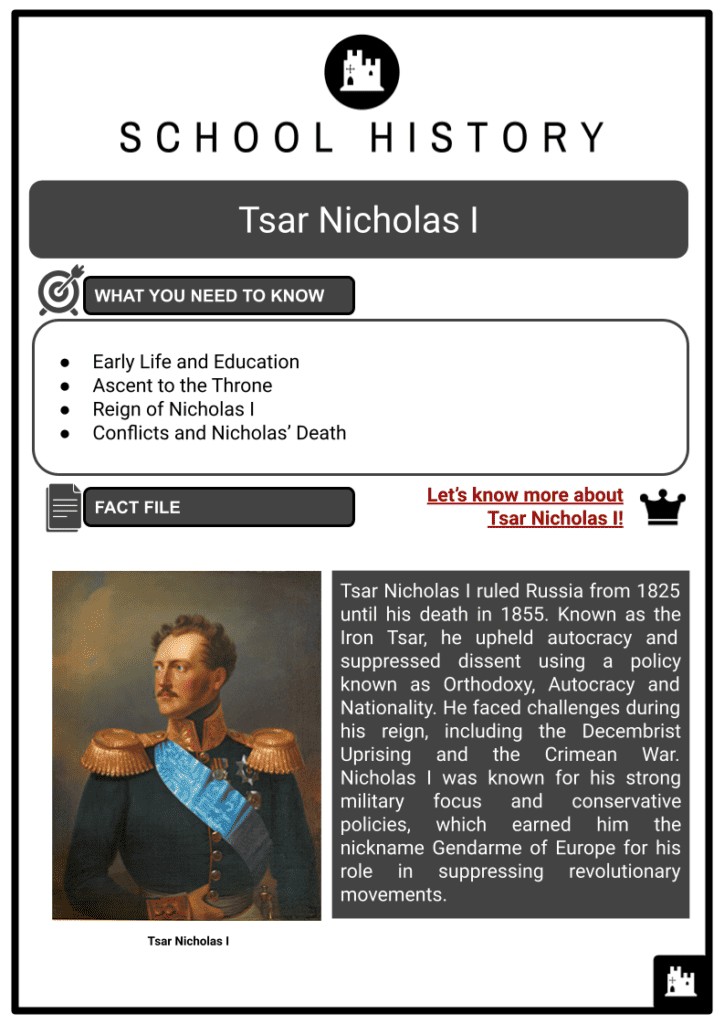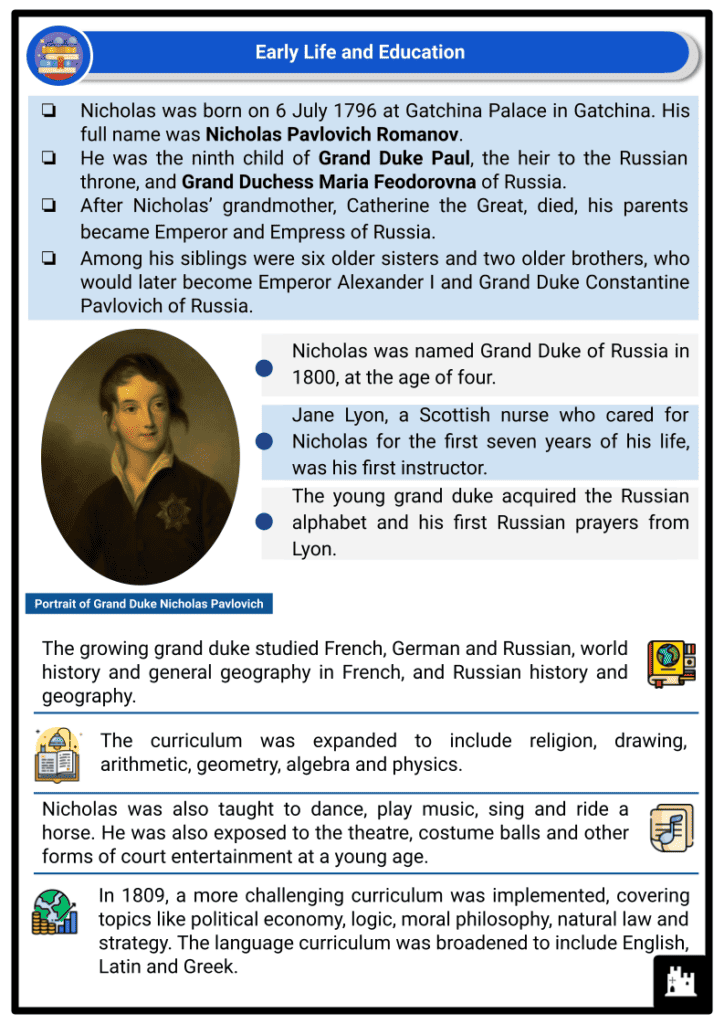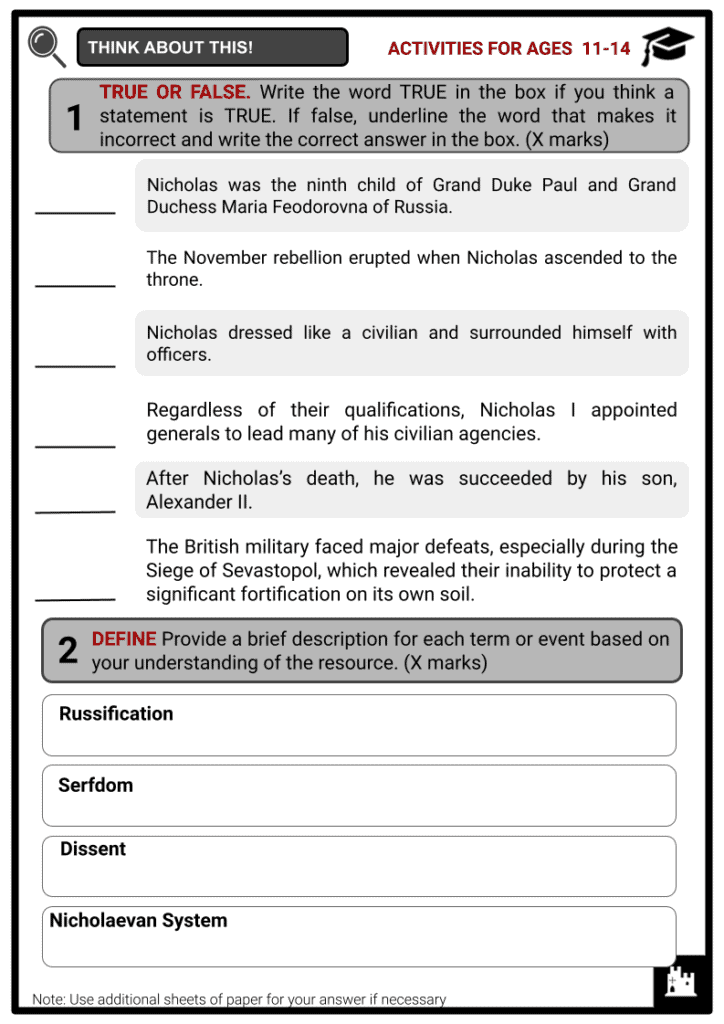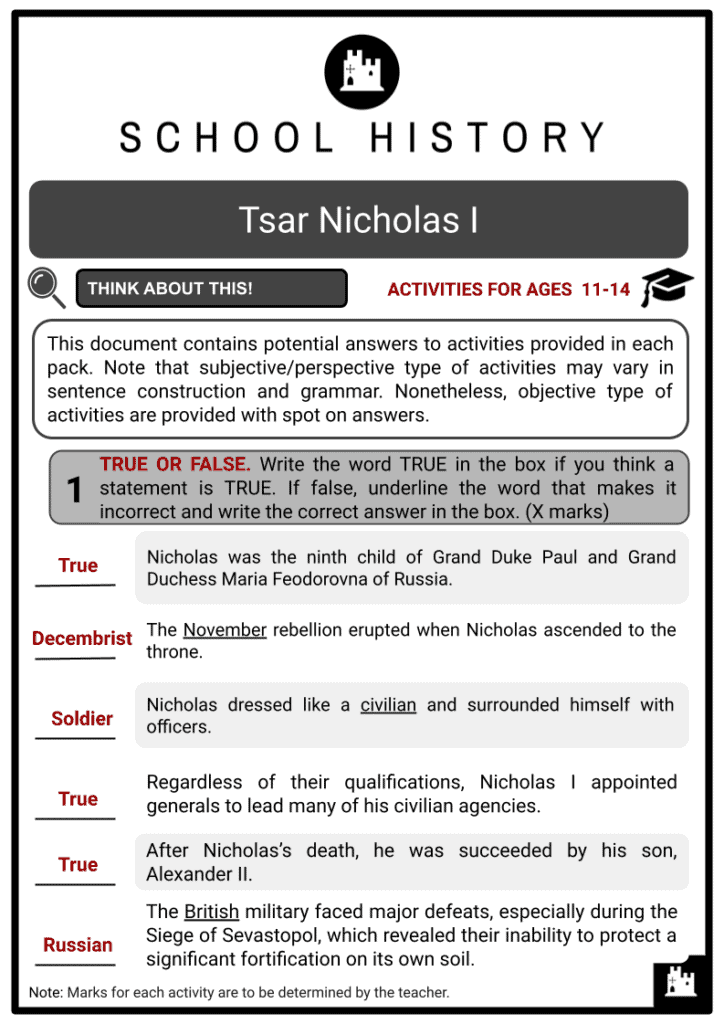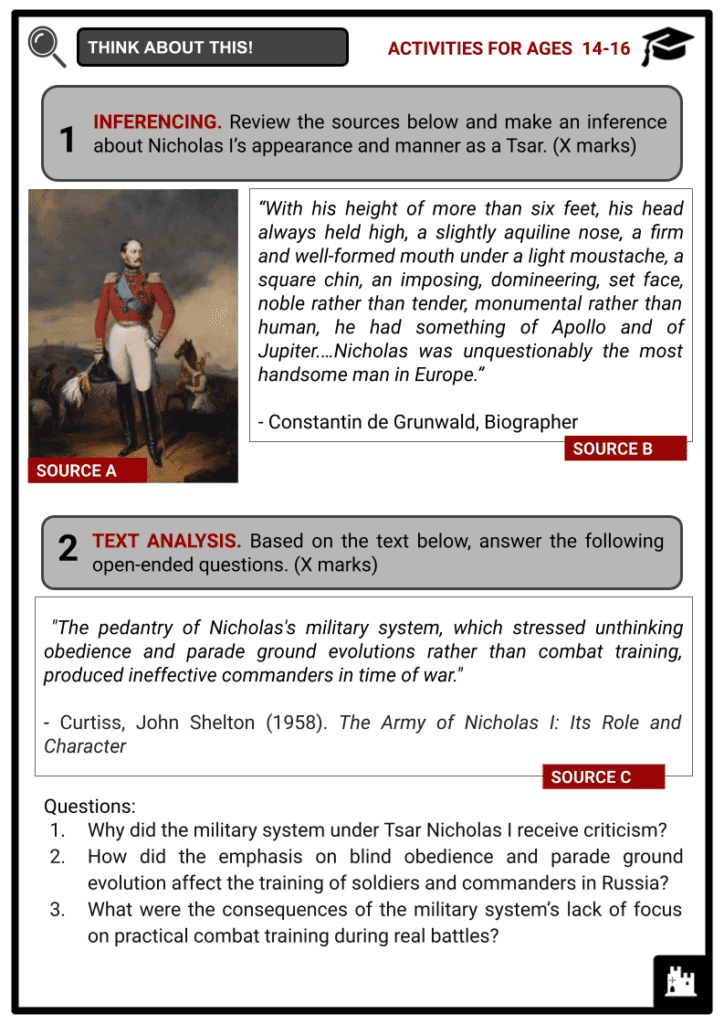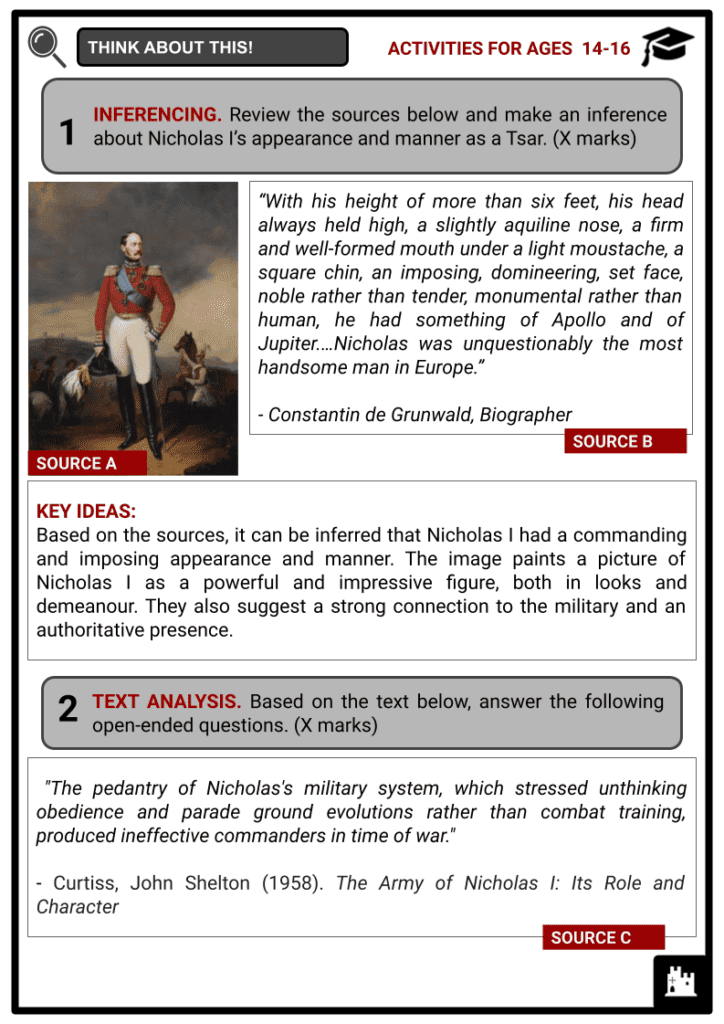Tsar Nicholas I Worksheets
Do you want to save dozens of hours in time? Get your evenings and weekends back? Be able to teach about Tsar Nicholas I to your students?
Our worksheet bundle includes a fact file and printable worksheets and student activities. Perfect for both the classroom and homeschooling!
Summary
- Early Life and Education
- Ascent to the Throne
- Reign of Nicholas I
- Conflicts and Nicholas’ Death
Key Facts And Information
Let’s know more about Tsar Nicholas I!
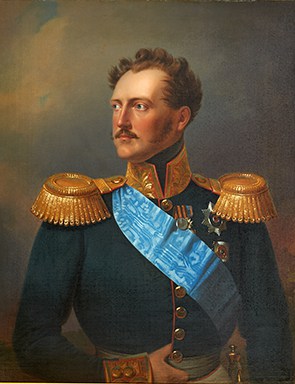
Tsar Nicholas I ruled Russia from 1825 until his death in 1855. Known as the Iron Tsar, he upheld autocracy and suppressed dissent using a policy known as Orthodoxy, Autocracy and Nationality. He faced challenges during his reign, including the Decembrist Uprising and the Crimean War. Nicholas I was known for his strong military focus and conservative policies, which earned him the nickname Gendarme of Europe for his role in suppressing revolutionary movements.
Early Life and Education
- Nicholas was born on 6 July 1796 at Gatchina Palace in Gatchina. His full name was Nicholas Pavlovich Romanov.
- He was the ninth child of Grand Duke Paul, the heir to the Russian throne, and Grand Duchess Maria Feodorovna of Russia.
- After Nicholas’ grandmother, Catherine the Great, died, his parents became Emperor and Empress of Russia.
- Among his siblings were six older sisters and two older brothers, who would later become Emperor Alexander I and Grand Duke Constantine Pavlovich of Russia.
- Nicholas was named Grand Duke of Russia in 1800, at the age of four.
- Jane Lyon, a Scottish nurse who cared for Nicholas for the first seven years of his life, was his first instructor.
- The young grand duke acquired the Russian alphabet and his first Russian prayers from Lyon.
- The growing grand duke studied French, German and Russian, world history and general geography in French, and Russian history and geography.
- The curriculum was expanded to include religion, drawing, arithmetic, geometry, algebra and physics.
- Nicholas was also taught to dance, play music, sing and ride a horse. He was also exposed to the theatre, costume balls and other forms of court entertainment at a young age.
- In 1809, a more challenging curriculum was implemented, covering topics like political economy, logic, moral philosophy, natural law and strategy. The language curriculum was broadened to include English, Latin and Greek.
- Nicholas married Princess Charlotte of Prussia on 13 July 1817, who converted to Orthodoxy and adopted the name Alexandra Feodorovna.
- The match symbolised a dynastic and political arrangement that both ruling dynasties sought.
- Nicholas was not only deeply in love with his wife, but he also developed a close relationship with his father-in-law, Frederick William III of Prussia.
- The great Napoleonic Wars of 1812–1815 substantially cut short and disrupted Nicholas’s schooling as well as that of his younger brother.
- The grand dukes were permitted to enlist in the army in 1814, and although they did not participate in any actual combat, they experienced the intense emotions of those historic years and benefited from the chance to travel to Paris and other locations in western and central Europe.
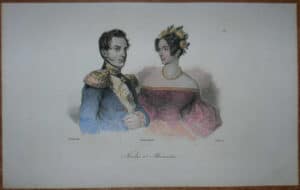
Princess Charlotte of Prussia and Grand Duke Nicholas Pavlovich of Russia
- Nicholas was sent on two educational journeys: a lengthy tour of Russia in 1816 that lasted from May to September, and a trip to England in late 1816 and early 1817.
- The Russian journey covered much ground quickly, and it is interesting to historians because of the notes Nicholas made on everything he saw and heard.
- In England, Nicholas spent most of his time in London. While he did attend the opening of Parliament and gained some understanding of English politics in general, his only recorded views on the subject were negative. Examining military and naval bases was considerably more appealing to him.
Ascent to the throne
- Having two older brothers, it appeared unlikely that Nicholas would ever become Tsar.
- However, the unexpected demise of Alexander I in southern Russia on 1 December 1825 created a dynastic crisis.
- As Alexander I had no direct male heir, the next in line for the throne was Constantine.
- However, Constantine had forfeited his right to the crown by marrying a non-royal Polish woman in 1820.
- Consequently, Nicholas was designated as the next ruler of Russia in a manifesto confirmed by Alexander I’s signature in 1822.
- Nevertheless, the manifesto was not made public, and this raised doubts for Nicholas regarding the legality of the situation and the country’s expectations for Constantine's succession.
- Despite this uncertainty, Constantine and the Polish kingdom, where he served as commander-in-chief, pledged allegiance to Nicholas, while Nicholas, the Russian capital and the Russian army swore allegiance to Constantine.
- Only after Constantine adamantly maintained his stance and considerable time had passed did Nicholas make the decision to publish Alexander’s manifesto, officially becoming the emperor of Russia.
- On 14 December 1825, during the moment when the guard regiments in St Petersburg were to swear allegiance to Nicholas, the Decembrist rebellion erupted.
- The liberal conspirators, many of whom were officers in the army, used their influence to incite mutiny in several units, rallying them to defend Constantine’s rightful claim against his brother’s alleged usurpation.
- Despite about 3,000 misled rebels marching to the Senate Square, the rebellion ultimately failed by nightfall, and Nicholas I ascended the throne through a struggle involving his own subjects and confronting the revolution.
Reign of Nicholas I
Local Policies
- After the Decembrist revolt early in his reign, Nicholas I was determined to exert strict control over Russian society.
- The Imperial Chancellery’s Third Section established an extensive network of spies and informers, assisted by Gendarmes (army).
- The government imposed censorship and closely regulated education, publishing, and any public activities or expressions of dissent.
- In 1833, Sergey Uvarov, from the Ministry of National Education, created a programme called Orthodoxy, Autocracy and Nationality to guide the government’s policies.
- This approach aimed to maintain a conservative stance, with an emphasis on the Russian Orthodox Church in religion, absolute monarchy in governance, and the promotion of Russian national identity and equal citizen rights for all other peoples occupying Russia, with the exclusion of Jewish people.
- Nicholas despised serfdom and considered abolishing it in Russia, but declined for political reasons. He feared the aristocracy would turn against him if he abolished serfdom. Serfdom was a form of servitude and debt bondage that existed in Europe during Late Antiquity and the Early Middle Ages. It had similarities to and differences from slavery, and it persisted in some countries until the mid-19th century.
- With the assistance of his minister, Pavel Kiselyov, he did take some steps to improve the conditions of the Crown Serfs (government-owned serfs).
- In 1831, Nicholas I limited voting rights in the Noble Assembly to those who owned more than 100 serfs, resulting in 21,916 eligible voters. Then, in 1841, he prohibited landless nobles from selling serfs separately from the land they worked on.
Military Policy
- Nicholas became convinced that Russia required strong order and firm leadership, which only the autocrat could provide.
- The Nicholaevan system of government was established on these principles and stemmed from the Tsar’s lack of trust in the Russian gentry after the revolt.
- Nicholas appointed a group of ministers to key positions and heavily relied on them for governance.
- Regardless of their qualifications, Nicholas I appointed generals to lead many of his civilian agencies.
- Despite having outdated equipment and tactics, the Tsar took great pride in the victory over Napoleon in 1812 and admired the army’s smart appearance during parades. He dressed like a soldier and surrounded himself with officers. However, the cavalry horses, which were only trained for parades, performed poorly in actual battles.
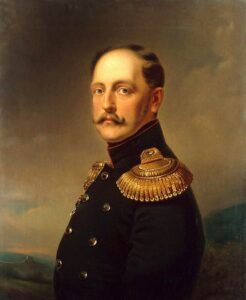
Portrait of Nicholas I - The military exerted a significant influence on the government during Nicholas I’s reign. They emphasised following orders, strict obedience and precision, especially in official matters and public appearances.
- Nicholas I frequently avoided regular procedures and disliked formal discussions or delays when dealing with state affairs. As a result, the significance of institutions like the Committee of Ministers, the State Council and the Senate diminished over time. Instead, the Tsar increasingly relied on special bureaucratic methods designed to swiftly implement his decisions, while keeping them entirely under his direct authority.
Foreign Policy
- In matters of foreign policy, Nicholas I positioned himself as a defender of ruling legitimacy and a safeguard against revolution. His proposals to suppress revolutions across Europe, mirroring his elder brother Alexander I’s approach, led to him being called the Gendarme of Europe.
- On 12 May 1829, Nicholas was crowned King of Poland in Warsaw, adhering to the Polish Constitution. He holds the distinction of being the sole Russian monarch to receive the title of King of Poland, though he is not the only one to be bestowed with such an honour.
- Upon ascending to the throne, he started to reduce the freedoms that were present under the constitutional monarchy in Congress Poland. In 1830, he was angered by the Belgian revolt against the Dutch and swiftly commanded the Imperial Russian Army to prepare for action.
- When the November Uprising erupted in 1831, the Polish parliament removed Nicholas as King of Poland due to his consistent undermining of their constitutional rights.
- The November Uprising (1830–31), also called the Polish–Russian War, was a rebellion in central Poland against the Russian Empire. It started on 29 November 1830 in Warsaw, when young Polish officers from the military academy of the Army of Congress Poland initiated the revolt. The uprising gained support from many people in Lithuania, Belarus and Right-bank Ukraine, who also joined the rebellion.
- In response, Nicholas sent Russian troops into Poland and forcefully suppressed the rebellion. He proceeded to completely abolish the Polish constitution and transformed Poland into a province named Vistula Land.
- Nicholas then initiated a policy of suppressing Polish culture, starting with the suppression of the Polish Catholic Church. In the 1840s, he demoted 64,000 Polish nobles to the status of commoners.
- In 1848, during a period of revolutions across Europe, Nicholas played a prominent role as a reactionary figure. In 1849, he actively aided the Habsburgs in suppressing the uprising in Hungary and advised Prussia against adopting a liberal constitution.
Conflicts and Nicholas’ Death
- In 1828–1829, Russia engaged in a war with the Ottoman Empire due to disputes concerning the rights of Christian subjects in Turkey and territorial disagreements between the two empires. The outcome of the fighting was mixed, but Russia saw itself as the winner and obtained some concessions from the Ottoman Empire.
- In 1830, a revolt erupted in Poland, which was part of the Russian Empire. The rebellion spread to other regions, and Nicholas I sent troops to suppress it in 1831. After the revolt, Nicholas imposed the Organic Statute of 1832, giving Russia more control over Polish matters.
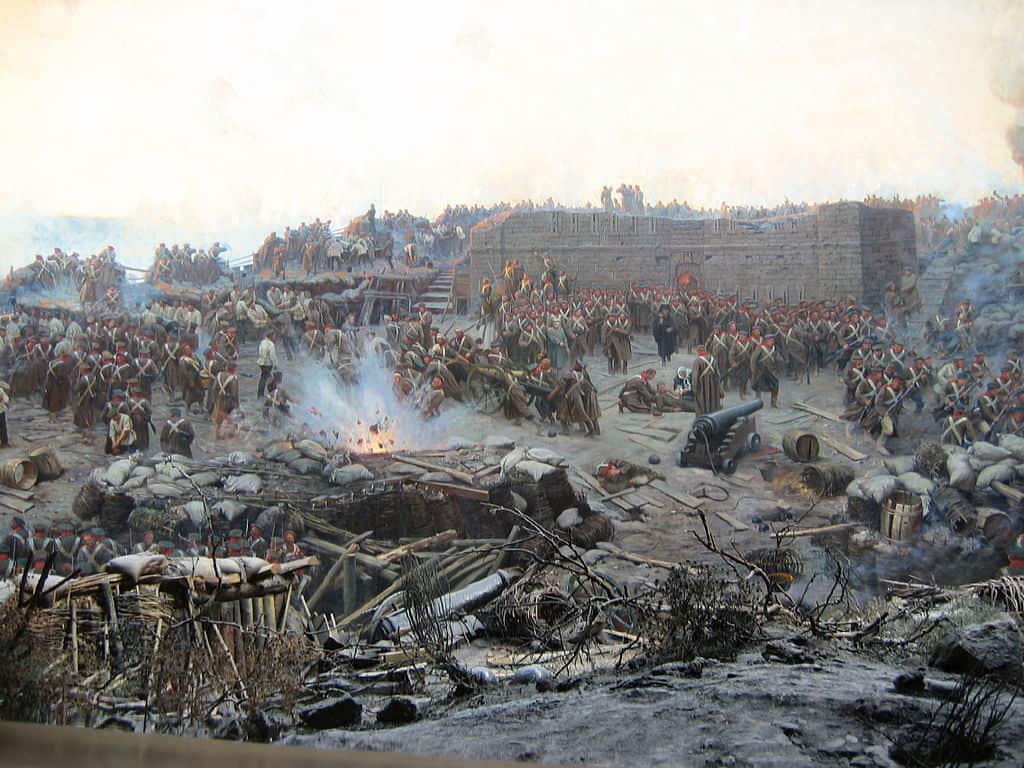
Siege of Sevastopol - This event reminded Nicholas of a previous revolt in 1825, prompting him to implement more Russification policies across his empire. Though the rebellion was quelled, nationalist sentiments in Poland, Ukraine and other regions would pose challenges for future Russian rulers.
- Nicholas I’s aggressive foreign policy and territorial ambitions in the Ottoman Empire’s territories led to tensions with other European powers, particularly Britain, France and the Ottoman Empire.
- Russia’s invasion of the Ottoman-controlled territories in the Balkans, which threatened the balance of power in the region, provoked the Crimean War.
- In support of the Ottoman Empire and to protect their own interests, Britain and France declared war on Russia.
- As a result, Russia ended up in a conflict with all the Great Powers of Europe, either through military alliances or diplomatic opposition.
- Nicholas’s decision to escalate tensions and invade the Ottoman territories was driven by his desire to assert Russian dominance in the region and protect the rights of Orthodox Christians living under Ottoman rule.
- He believed that Russia had a right to intervene in the ‘Eastern Question’ – the fate of the declining Ottoman Empire and the control of its territories.
- However, the war did not go as planned for Russia. The Russian military faced major defeats, especially during the Siege of Sevastopol, which became a critical moment in the war. As the base fell, it revealed Russia's inability to protect a significant fortification on its own soil.
- After Nicholas I’s death, Alexander II ascended to the throne as the new Tsar.
- On 15 January 1856, he decided to withdraw Russia from the war on unfavourable terms.
- Nicholas passed away on 2 March 1855, while the Crimean War was ongoing, at the Winter Palace in St Petersburg.
- He caught a chill and declined medical assistance, ultimately succumbing to pneumonia.
- Some rumours suggested that he might have chosen not to seek treatment as a form of passive suicide.
- His final resting place is in the Peter and Paul Cathedral in St Petersburg.
- After ruling for 30 years, he was succeeded by his son, Alexander II.
Image Sources
- https://upload.wikimedia.org/wikipedia/commons/6/63/Nicholas_I%2C_Emperor_of_Russia%2C_attributed_to_Franz_Kr%C3%BCger%2C_c._1832.jpg
- https://en.wikipedia.org/wiki/Alexandra_Feodorovna_(Charlotte_of_Prussia)#/media/File:Tsar_Nicholas_I_and_his_wife.jpg
- https://en.wikipedia.org/wiki/Nicholas_I_of_Russia#/media/File:Botman_-_Emperor_Nicholas_I_(cropped).jpg
- https://en.wikipedia.org/wiki/Siege_of_Sevastopol_%281854%E2%80%931855%29#/media/File:Panorama_dentro.JPG
Frequently Asked Questions
- Who was Tsar Nicholas I?
Tsar Nicholas I, also known as Nicholas Pavlovich, was the ruler of Russia from 1825 to 1855. He belonged to the Romanov dynasty and was known for his strong autocratic rule.
- What were Tsar Nicholas I's major accomplishments?
Nicholas I is known for his efforts to maintain autocratic control over Russia and his conservative policies to suppress political dissent and maintain the status quo. He also played a role in expanding Russian influence in the Caucasus and Central Asia.
- Who ruled Russia after Nicholas 1?
After Tsar Nicholas I, his son Alexander II ruled Russia from 1855 to 1881. Alexander II is known for implementing a series of reforms, including the emancipation of the serfs in 1861, which aimed to modernise and transform various aspects of Russian society and government.

